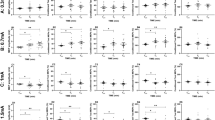Abstract
Transcranial magnetic stimulation (TMS) interventions that modulate cortical plasticity may achieve a more functional benefit if combined with neuro-rehabilitation therapies. With a TMS protocol targeting I-wave dynamics, it is possible to deliver stimuli while a subject performs a motor task, and this may more effectively target functional networks related to the task. However, the efficacy of this intervention during a simple task such as a low-level voluntary contraction is not known. We delivered paired-pulse TMS at an inter-pulse interval (IPI) of 1.5 ms for 15 min while subjects performed a 10 ± 2.5% voluntary contraction of the first dorsal interosseous (FDI) muscle and made motor evoked potential (MEP) amplitude and short-interval intracortical facilitation (SICF) curve measurements. Pre-intervention SICF curves showed only a single peak at 1.3–1.5 ms IPI. During the intervention, MEP amplitude steadily increased (P < 0.001) to 137 ± 13% of its initial value. After the intervention, SICF curves were increased in amplitude (P < 0.001) and later peaks emerged at 2.8 and 4.3 ms IPIs. A control experiment, replacing paired-pulse stimulation with single-pulse stimulation showed no effect on MEP amplitude (P = 0.951). We conclude that the I-wave intervention can be administered concurrently with a simple motor task and that it acts by increasing trans-synaptic efficacy across a number of I-waves. The ability to perform a motor task simultaneously with a TMS intervention could confer a degree of specificity to the induced excitability changes and may be beneficial for functional neuro-rehabilitation programs built around motor learning and retraining.





Similar content being viewed by others
References
Benwell NM, Mastaglia FL, Thickbroom GW (2006) Paired-pulse rTMS at trans-synaptic intervals increases corticomotor excitability and reduces the rate of force loss during a fatiguing exercise of the hand. Exp Brain Res 175:626–632
Cash RF, Benwell NM, Murray K, Mastaglia FL, Thickbroom GW (2009) Neuromodulation by paired-pulse TMS at an I-wave interval facilitates multiple I-waves. Exp Brain Res 193:1–7
Di Lazzaro V, Restuccia D, Oliviero A, Profice P, Ferrara L, Insola A, Mazzone P, Tonali P, Rothwell JC (1998) Effects of voluntary contraction on descending volleys evoked by transcranial stimulation in conscious humans. J Physiol 508(Pt 2):625–633
Di Lazzaro V, Thickbroom GW, Pilato F, Profice P, Dileone M, Mazzone P, Insola A, Ranieri F, Tonali PA, Rothwell JC (2007) Direct demonstration of the effects of repetitive paired-pulse transcranial magnetic stimulation at I-wave periodicity. Clin Neurophysiol 118:1193–1197
Fitzgerald PB, Fountain S, Daskalakis ZJ (2006) A comprehensive review of the effects of rTMS on motor cortical excitability and inhibition. Clin Neurophysiol 117:2584–2596
Hallett M (2007) Transcranial magnetic stimulation: a primer. Neuron 55:187–199
Hamada M, Hanajima R, Terao Y, Arai N, Furubayashi T, Inomata-Terada S, Yugeta A, Matsumoto H, Shirota Y, Ugawa Y (2007) Origin of facilitation in repetitive, 1.5 ms interval, paired pulse transcranial magnetic stimulation (rPPS) of the human motor cortex. Clin Neurophysiol 118:1596–1601
Hanajima R, Ugawa Y, Terao Y, Enomoto H, Shiio Y, Mochizuki H, Furubayashi T, Uesugi H, Iwata NK, Kanazawa I (2002) Mechanisms of intracortical I-wave facilitation elicited with paired-pulse magnetic stimulation in humans. J Physiol 538:253–261
Khedr EM, Farweez HM, Islam H (2003) Therapeutic effect of repetitive transcranial magnetic stimulation on motor function in Parkinson’s disease patients. Eur J Neurol 10:567–572
Kim YH, You SH, Ko MH, Park JW, Lee KH, Jang SH, Yoo WK, Hallett M (2006) Repetitive transcranial magnetic stimulation-induced corticomotor excitability and associated motor skill acquisition in chronic stroke. Stroke 37:1471–1476
Orth M, Rothwell JC (2004) The cortical silent period: intrinsic variability and relation to the waveform of the transcranial magnetic stimulation pulse. Clin Neurophysiol 115:1076–1082
Pomeroy VM, Cloud G, Tallis RC, Donaldson C, Nayak V, Miller S (2007) Transcranial magnetic stimulation and muscle contraction to enhance stroke recovery: a randomized proof-of-principle and feasibility investigation. Neurorehabil Neural Repair 21:509–517
Reis J, Robertson E, Krakauer JW, Rothwell J, Marshall L, Gerloff C, Wassermann E, Pascual-Leone A, Hummel F, Celnik PA, Classen J, Floel A, Ziemann U, Paulus W, Siebner HR, Born J, Cohen LG (2008) Consensus: “Can tDCS and TMS enhance motor learning and memory formation?”. Brain Stimulat 1:363–369
Ridding MC, Rothwell JC (2007) Is there a future for therapeutic use of transcranial magnetic stimulation? Nat Rev Neurosci 8:559–567
Sacco P, Thickbroom GW, Thompson ML, Mastaglia FL (1997) Changes in corticomotor excitation and inhibition during prolonged submaximal muscle contractions. Muscle Nerve 20:1158–1166
Thickbroom GW (2007) Transcranial magnetic stimulation and synaptic plasticity: experimental framework and human models. Exp Brain Res 180:583–593
Thickbroom GW (2010) A model of the contribution of late I-waves to α-motoneuronal activation: implications for paired-pulse TMS. Brain Stimulat. doi:10.1016/j.brs.2010.04.002
Thickbroom GW, Byrnes ML, Edwards DJ, Mastaglia FL (2006) Repetitive paired-pulse TMS at I-wave periodicity markedly increases corticospinal excitability: a new technique for modulating synaptic plasticity. Clin Neurophysiol 117:61–66
Tokimura H, Ridding MC, Tokimura Y, Amassian VE, Rothwell JC (1996) Short latency facilitation between pairs of threshold magnetic stimuli applied to human motor cortex. Electroencephalogr Clin Neurophysiol 101:263–272
Werhahn KJ, Kunesch E, Noachtar S, Benecke R, Classen J (1999) Differential effects on motorcortical inhibition induced by blockade of GABA uptake in humans. J Physiol 517(Pt 2):591–597
Wilson SA, Lockwood RJ, Thickbroom GW, Mastaglia FL (1993) The muscle silent period following transcranial magnetic cortical stimulation. J Neurol Sci 114:216–222
Ziemann U, Rothwell JC (2000) I-waves in motor cortex. J Clin Neurophysiol 17:397–405
Ziemann U, Tergau F, Wassermann EM, Wischer S, Hildebrandt J, Paulus W (1998) Demonstration of facilitatory I wave interaction in the human motor cortex by paired transcranial magnetic stimulation. J Physiol 511(Pt 1):181–190
Author information
Authors and Affiliations
Corresponding author
Rights and permissions
About this article
Cite this article
Silbert, B.I., Gibbons, J.T., Cash, R.H.F. et al. Modulation of corticomotor excitability by an I-wave intervention delivered during low-level voluntary contraction. Exp Brain Res 208, 229–235 (2011). https://doi.org/10.1007/s00221-010-2473-2
Received:
Accepted:
Published:
Issue Date:
DOI: https://doi.org/10.1007/s00221-010-2473-2




